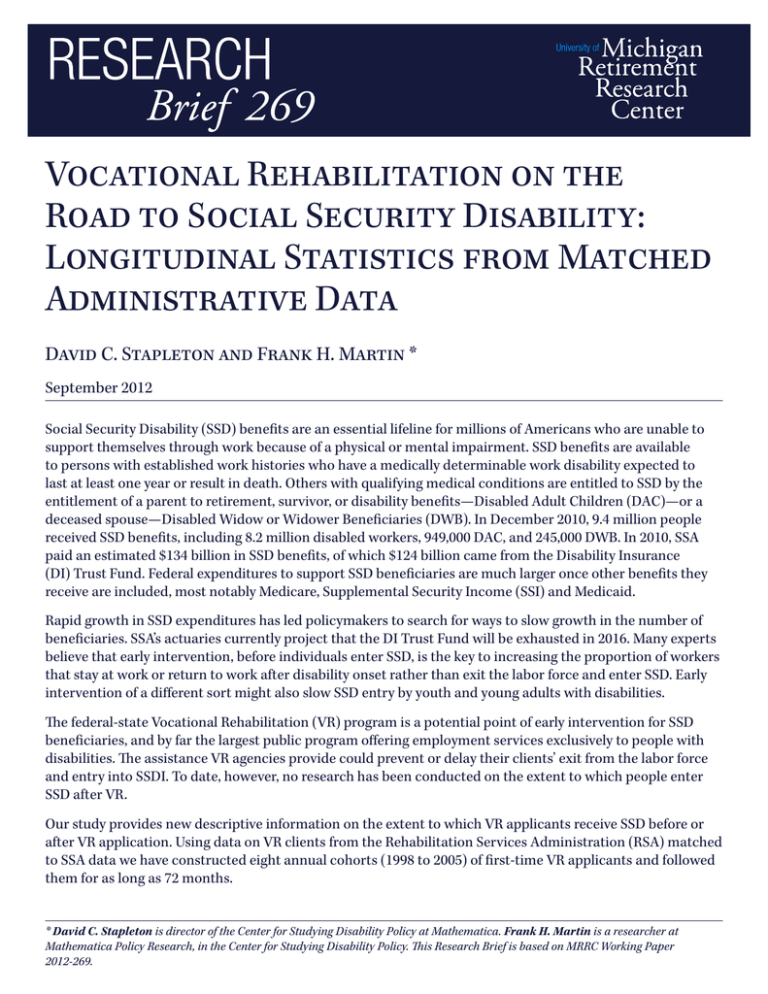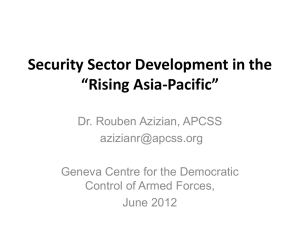Document 10414966
advertisement

Vocational Rehabilitation on the Road to Social Security Disability: Longitudinal Statistics from Matched Administrative Data David C. Stapleton and Frank H. Martin * September 2012 Social Security Disability (SSD) benefits are an essential lifeline for millions of Americans who are unable to support themselves through work because of a physical or mental impairment. SSD benefits are available to persons with established work histories who have a medically determinable work disability expected to last at least one year or result in death. Others with qualifying medical conditions are entitled to SSD by the entitlement of a parent to retirement, survivor, or disability benefits—Disabled Adult Children (DAC)—or a deceased spouse—Disabled Widow or Widower Beneficiaries (DWB). In December 2010, 9.4 million people received SSD benefits, including 8.2 million disabled workers, 949,000 DAC, and 245,000 DWB. In 2010, SSA paid an estimated $134 billion in SSD benefits, of which $124 billion came from the Disability Insurance (DI) Trust Fund. Federal expenditures to support SSD beneficiaries are much larger once other benefits they receive are included, most notably Medicare, Supplemental Security Income (SSI) and Medicaid. Rapid growth in SSD expenditures has led policymakers to search for ways to slow growth in the number of beneficiaries. SSA’s actuaries currently project that the DI Trust Fund will be exhausted in 2016. Many experts believe that early intervention, before individuals enter SSD, is the key to increasing the proportion of workers that stay at work or return to work after disability onset rather than exit the labor force and enter SSD. Early intervention of a different sort might also slow SSD entry by youth and young adults with disabilities. The federal-state Vocational Rehabilitation (VR) program is a potential point of early intervention for SSD beneficiaries, and by far the largest public program offering employment services exclusively to people with disabilities. The assistance VR agencies provide could prevent or delay their clients’ exit from the labor force and entry into SSDI. To date, however, no research has been conducted on the extent to which people enter SSD after VR. Our study provides new descriptive information on the extent to which VR applicants receive SSD before or after VR application. Using data on VR clients from the Rehabilitation Services Administration (RSA) matched to SSA data we have constructed eight annual cohorts (1998 to 2005) of first-time VR applicants and followed them for as long as 72 months. * David C. Stapleton is director of the Center for Studying Disability Policy at Mathematica. Frank H. Martin is a researcher at Mathematica Policy Research, in the Center for Studying Disability Policy. This Research Brief is based on MRRC Working Paper 2012-269. Our analysis shows that just over half of first-time VR applicants were disability insured (that is, met the workhistory eligibility criterion for disabled worker benefits) at the time of application. Only a much smaller share of all first-time applicants have entered SSD before applying for VR services — 6.3 percent in the 2003 cohort, for instance, or about 28,000 individuals. A much larger share of first-time applicants entered SSD in the 60 months following VR application — 11.3 percent in the 2003 cohort, or more than 50,000 individuals. Most of the later SSD entrants were disability insured at VR application, but a significant number were not. We also found that SSD entry varies with VR applicant characteristics. SSD entry was remarkably high for those who had entered SSI before applying for VR services. For instance, for the approximately 20,000 VR applicants in 2002 who had already entered SSI, the percentage who had entered SSD increased from 28 percent at VR application to 94 percent 60 months later. Other VR applicant groups with relatively high SSD entry include non-Hispanic whites, those not employed at application, and those with more than a high school education. We find wide variation in SSD entry across states, with some states having entry percentages twice as high as others. While a large number of VR applicants enter SSD after VR application, the number is modest by comparison to the number entering SSD ( for instance, 829,831 in 2003). Hence, any current impact of VR services on SSD entry must be small relative to the number of SSD entrants. Even so, the impact on SSD and Medicare expenditures could be in the billions of dollars on an annual basis because of the high annual cost and long duration of benefits. For instance, if VR services annually delay or accelerate SSD entry by the equivalent of 10,000 workers for an average of 10 years, the annual impact on SSD and Medicare expenditures combined would be on the order of $1.7 billion — about half the size of annual federal expenditures for the VR services. Although VR services could potentially delay SSD entry, VR agencies have greater incentives to serve existing SSD beneficiaries than those who have not yet entered SSD, and even to accelerate SSD entry; a VR applicant’s entry into SSD might increase the chance that SSA will pay for services provided and eventually reduce state Medicaid expenditures. Hence, it would be useful to know whether VR services currently increase or reduce SSD entry. Toward this end, we explored the possibility of estimating the impact of often long VR waiting times on applicant entry into SSD. We have described an attractive non-experimental study that would attempt to separate the impacts of long wait times from various confounding factors. It is important to recognize, however, that as with any non-experimental approach there is uncertainty about how well the analysis would separate the true impacts of wait times from the effects of confounding factors. Whatever the effects of current VR services, policymakers are likely to be interested in how potential policy changes might reduce SSD entry by VR applicants. Perhaps a more aggressive effort to have VR agencies help workers with disabilities stay in the labor force rather than enter SSD would pay for itself through reduced SSD, Medicare and other expenditures, although there is no guarantee. SSA once developed a plan to conduct a test of early intervention services provided by state VR agencies to SSD applicants as part of a broader early intervention test, but that plan was not pursued. Our findings suggest that such a test deserves further consideration. University of Michigan Retirement Research Center Institute for Social Research 426 Thompson Street Room 3026 Ann Arbor, MI 48104-2321 Phone: (734) 615-0422 Fax: (734) 615-2180 mrrcumich@umich.edu www.mrrc.isr.umich.edu The research reported herein was performed pursuant to a grant from the U.S. Social Security Administration (SSA) through the Michigan Retirement Research Center (MRRC). The findings and conclusions expressed are solely those of the author(s) and do not represent the views of SSA, any agency of the federal government, or the MRRC. Regents of the University of Michigan: Julia Donovan Darlow, Laurence B. Deitch, Denise Ilitch, Olivia P. Maynard, Andrea Fischer Newman, Andrew C. Richner, S. Martin Taylor, Katherine E. White, Mary Sue Coleman, Ex Officio




